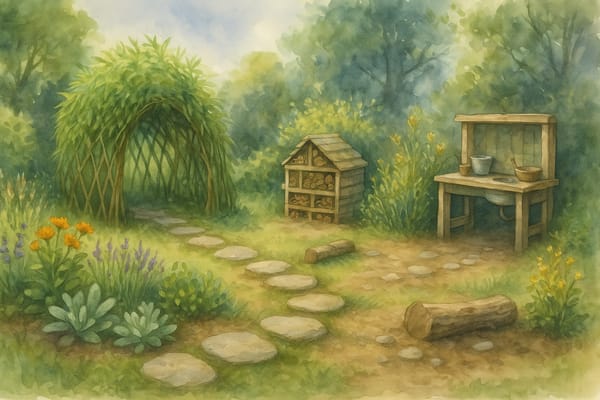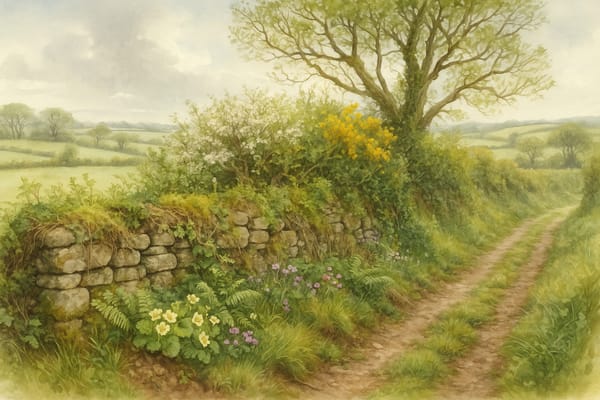In a world where screens often outcompete outdoor adventures, a Wild Play Corner brings nature’s wonder right into your garden — a place where imagination roams, hands get muddy, and curiosity flourishes. These spaces don’t just encourage play; they nurture healthy development, family bonding, and lifelong ecological awareness.
A Wild Play Corner invites children to connect with nature through discovery, creativity, and exploration. With simple natural features — living willow tunnels, sensory beds, bug hotels, and safe wild spaces — you’ll transform your garden into a living classroom and a cherished haven for young adventurers.
Willow Tunnels and Dens — Living Hideaways for Imaginative Play
Few features capture a child’s imagination like a living willow tunnel or dome. Woven from flexible willow rods, these structures create green passageways and cozy dens that change with the seasons.
Children love crawling through leafy tunnels, watching spring catkins appear, or hiding beneath summer’s lush growth. They become castles, dens, or secret lairs — always ready for a new story.
Willow is quick to root, low-maintenance, and a perfect introduction to hands-on gardening. With simple weaving in spring and light pruning through the year, your tunnel grows as the children grow — a living landmark in their adventures.
Sensory Beds — A Garden for the Senses
A sensory bed weaves color, texture, scent, and sound into a playful, engaging space. By planting soft lamb’s ear, rustling grasses, aromatic mint, lavender, and edible herbs, you create a multi-sensory experience that sparks curiosity and language.
Children delight in feeling fuzzy leaves, sniffing scented pelargoniums, and spotting bright nasturtiums. Add a “feely” basket of pinecones, shells, and stones, and even simple activities like plant-watering become moments of connection with nature.
Bug Hotels and Wildlife Shelters — Little Habitats, Big Lessons
Building a bug hotel turns everyday garden play into a science project. With hollow stems, pinecones, logs, and bricks, children can stack, weave, and build tiny shelters for bees, beetles, and butterflies.
Bug hotels teach children empathy, ecological understanding, and the joy of observing life close-up. Watching a ladybird move in or a bee hover nearby makes abstract concepts like biodiversity and habitat feel wonderfully real.
Safe Exploration Zones — Where Wildness Meets Wonder
Create wild zones with stepping stones, log paths, and soft bark underfoot. A shallow pebble water tray, a mud kitchen corner, or even a supervised bramble patch invites balancing, jumping, digging, and discovery.
These informal spaces encourage gentle risk-taking — essential for building coordination, resilience, and confidence. And when children discover a beetle beneath a log or follow a butterfly to a flowering hedge, learning happens naturally.
Encouraging Young Gardeners — Tips for Wild Play Success
| Tip | Why It Works |
|---|
| Keep spaces informal | Supports free, creative play |
| Welcome gentle risks | Builds coordination and confidence |
| Involve kids in building | Grows ownership and hands-on skills |
| Use child-friendly tools | Encourages participation |
| Observe nature together | Sparks curiosity and focus |
| Embrace wild plants | Teaches about nature’s cycles |
The Real Benefits of Wild Play
Research confirms that outdoor play supports cognitive growth, resilience, coordination, and emotional well-being. Wild corners in the garden offer children a chance to:
- Develop practical skills like weaving, planting, and nature journaling
- Build empathy by caring for living creatures and habitats
- Experience social connection through shared play and family projects
- Strengthen mental health with stress-relieving, creative outdoor activity
Quick Start Guide — How to Build Your Wild Play Corner
- Choose a quiet, partially shaded spot.
- Plant living willow structures or build simple dens.
- Cluster sensory plants within easy reach.
- Stack natural materials into a child-made bug hotel.
- Scatter logs, stones, and simple balance paths.
- Add mud kitchens, water trays, or bramble zones for tactile play.
- Provide magnifiers, sketchbooks, or nature journals.
- Let children lead — embrace the muddy, curious, sometimes messy magic.
Wild Play as a Lifelong Gift
When you create a Wild Play Corner, you’re planting more than a space for fun — you’re growing curiosity, resilience, creativity, and a love for the natural world. These early moments of wild play lay the foundation for a deeper understanding of nature’s beauty and complexity.
So weave that willow, leave that messy patch, and invite little hands to explore, create, and wonder. You’re not just making a play space. You’re nurturing a lifelong connection to the living world.











